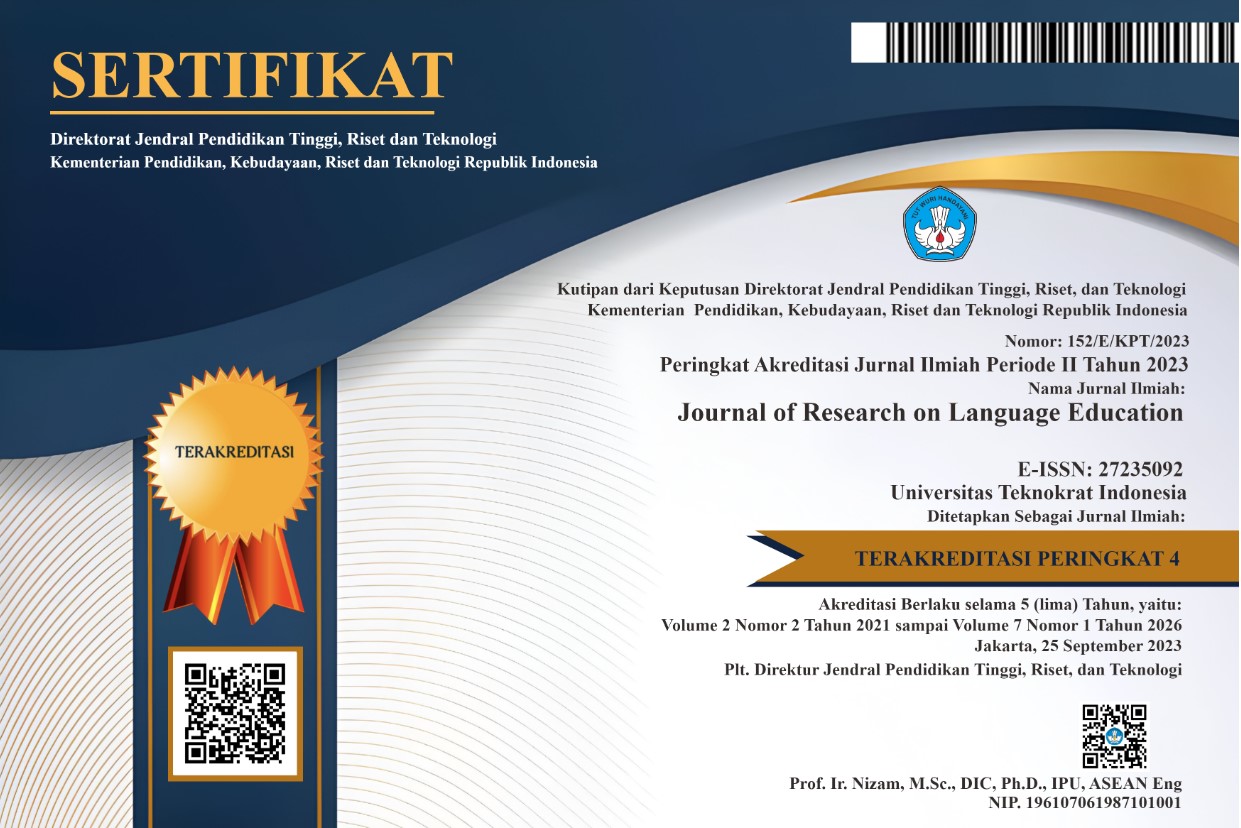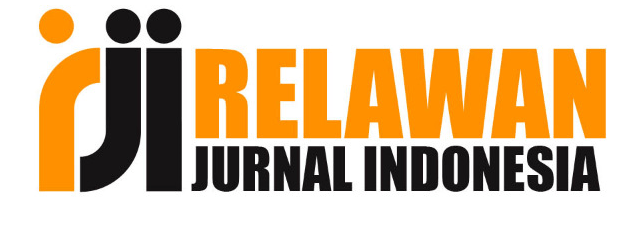EFL STUDENTS’ PERSPECTIVE ON WHATSAPP AS MEDIA OF ONLINE TEACHING AND LEARNING IN COVID-19 PANDEMIC
Abstract
The COVID-19 Pandemic indicated a unique challenge to the educational system. The Centers for Disease Control and Prevention recently advised doing social distancing. Many applications were developed and web-based. One of them was developed and become famous was WhatsApp. WhatsApp is one of the mobile phone applications and web-based social network that integrates with various features used to communicate with other users, ranging from education, business, and entertainment developed this social networking site. This study aimed to explore the EFL student’s perspective on WhatsApp as media on teaching and learning during this Pandemic. This paper used a qualitative descriptive method. The data was collected through questionnaire and call interview. After the research is conducted, we will find out how EFL students perspective WhatsApp as an online teaching-learning media during a pandemic.
Keywords
Full Text:
PDFReferences
Ahmed, S. (2019). Use of WhatsApp to enhance reading and writing skills. International Journal of English Language and Literature Studies, 8(2), 61–68. http://doi.org/10.18488/journal.23.2019.82.61.68
Alsaleem, B. I. A. (2013). The Effect of “WhatsApp” electronic dialogue journaling on improving writing vocabulary word choice and voice of EFL undergraduate Saudi students. Arab World English Journal, 4(3), 213-225.
Aminatun, D. & Oktaviani, L. (2019). Memrise: Promoting Students’ Autonomous Learning Skills through Language Learning Application. Metathesis: Journal of English Language, Literature, and Teaching, 3(2), 214-224. DOI: 10.31002/metathesis.v3i2.1982.
Amry, A.B. 2014. The Impact f Whatsapp Mobile Social Learning on The Achievement and Attitudes of Female Students Compared with Face to Face Learning in the classroom. European Scientific Journal. Vol.X. No.22 P 116-136
Andujar, A. (2016). Benefits of mobile instant messaging to develop ESL writing. System, 62, 63–76. http://doi.org/10.1016/j.system.2016.07.004
Asif, M. (2018). Mobile assisted language learning (MALL): Use of Whatsapp as an effective tool to support ESL/EFL writing skill. Remarking an Analisation, 3(9), 112–114.
Bangert, A. W. (2006). Identifying Factors Underlying the Quality of Online Teaching Effectiveness: An exploratory study. Journal of Computing in Higher Education 17(2): 79-99.
Beetham, H., & Sharpe, R. (Eds.). (2013). Rethinking pedagogy for a digital age: Designing for 21st-century learning. Routledge.
Bere A. A comparative study of student experiences of ubiquitous learning via mobile devices and learner management systems at a South African university. Proceedings of the 14th Annual Conference on World Wide Web Applications; Durban. 2012.
Çam, B., & Can, Y. (2019). The Effect of “WhatsApp” usage on the attitudes of students toward English self-efficacy and English courses in foreign language education outside the school. International Electronic Journal of Elementary Education, 11(3), 247–256. http://doi.org/10.26822/iejee.2019349249
Cavus, N., & Ibrahim, D. (2008). A Mobile Tool for Learning English Words. Online Submission.
Cavus, N., & Ibrahim, D. (2009). M-learning: An experiment in using SMS to support learning new English language words. British Journal of Educational Technology, 40(1), 78–91
Dziuban C., Moskal P. & Brophy J. (April 2006). Student satisfaction with Asynchronous Learning. JALN 11(1).
Gilbert, B., 2015. “Online Learning Revealing the Benefits and Challenges”.Education Masters. Paper 303, from https://fisherpub.sjfc.edu/education_ETD_masters/303. (Accessed on October 22, 2020, at 00.50).
Graham, C. R., S. Allen, and D. Ure. 2005. Benefits and challenges of blended learning environments. In M. Khosrow-Pour (ed.), Encyclopedia of information science and technology (pp. 253–259). Hershey, PA: Idea Group.
Habibi, A., Mukminin, A., Riyanto, Y., Prasojo, L. D., Sulistiyo, U., Sofwan, M., et al. (2018). Building an Online Community: Student Teachers’ Perceptions on the Advantages of Using Social Networking Services in a Teacher Education Program. Turkish Online Journal of Distance Education 19(1), 46-61.
Hashemifardnia, A., Namaziandost, E., & Esfahani, F. R. (2018). The Effect of using WhatsApp on Iranian EFL learners’ vocabulary learning. Journal of Applied Linguistics and Language Research, 5(3), 256–267.
Hiltz S. R. (1997). Impacts of College-Level Courses Via Asynchronous Learning Networks: Some Preliminary Results. JALN 2.
Hrastinski, S. (2008). Asynchronous and synchronous e-learning. Educause Quarterly, 31(4), 51–55.
Huang, C., Wang, Y., Li, X., Ren, L., Zhao, J., Hu, Y., Zhang, L., Fan, G., Xu, J., Gu, X., & Cheng, Z. (2020). Clinical features of patients infected with 2019 novel coronavirus in Wuhan, China. The Lancet, 395(10223), 497–506. https://doi.org/10. 1016/S0140-6736(20)30183-5
La Hanisi, A., Risdiany, R., Dwi Utami, Y., & Sulisworo, D. (2018). The use of WhatsApp in collaborative learning to improve English teaching and learning process. International Journal of Research Studies in Educational Technology, 7(1), 29–35. http://doi.org/10.5861/ijrset.2018.3004
Lam, Y., & Lawrence, G 2002, ‘Teacher-student role redefinition during a computer-based second language project: Are computers catalysts for empowering change?’ Computer Assisted Language Learning, vol. 15, no. 3, pp. 295-315.
Lestari, M. & Wahyudin, A. Y. (2020). Language Learning Strategies of Undergraduate EFL Students. Journal of English Language Teaching and Learning, 1(1), 25-30.
Loomis K.D. (June 2000). Learning Styles and Asynchronous Learning: Comparing the LASSI Model to Class Performance. JALN 4(1).
Marshall J. Learning with technology. Evidence that technology can, and does, support learning; 2002.
Naismith, L., Lonsdale, P., Vavoula, G. &Sharples, M. (2004) Literature Review in Mobile Technologies and learning. NESTA Future lab. Series. Report 11. NESTA Future lab. Available: http://elearning.typepad.com/thelearnedan/mobilelearning/reports/Futurelab review 11.pdf
Nasr, E., & Mustafa, E. (2018). The impact of YouTube, Skype and WhatsApp in improving EFL learners’ speaking skill. International Journal of Contemporary Applied Researches, 5(5), 18–31.
Nguyen, T. 2015. The Effectiveness of Online Learning: Beyond No Significant Difference and Future Horizons. MERLOT Journal of Online Learning and Teaching. Vol. 11, No. 2, June 2015.
Nihalani, P. K., & Mayrath, M. C. (2010). Statistics I. Findings from using an iPhone app in a higher education course. White Paper.
Oktaviani, L. & Desiarti, E. (2017). A Lecturer’s and Students’ Perspective toward Ethnic Snake Game in Speaking Class at Universitas Muhammadiyah Malang. TEKNOSASTIK: Journal Bahasa dan Sastra, 15(2), 53-59. DOI: https://doi.org/10.33365/ts.v15i2.98
Oktaviani, L. & Mandasari, B. (2020). Powtoon: A Digital Medium to Optimize Students’ Cultural Presentation in ELT Classroom. Teknosastik: Jurnal Bahasa dan Sastra, 18(1), 33-41. DOI: https://doi.org/10.33365/ts.v18i1.526.
Otte G. & Benke M. (May 2006). Online Learning: New Models for Leadership and Organization in Higher Education. JALN 10(2).
Prensky, M. (2007). How to teach with technology: keeping both teachers and students comfortable in an era of exponential change. Learning, 2, 40–46. Retrieved from http://partners.becta.org.uk/page_documents/research/emerging_technologies07_chapter4.pdf
Picciano, A., and Seaman, J., 2009. K–12 online learning: A 2008 follow-up of the survey of U.S. school district administrators. Needham, MA: Sloan Consortium. http://www.sloanconsortium.org/publications/survey/pdf/k12_online_learning_2008.pdf.
Richardson, J., & Lenarcic, J. (2008). Text Messaging as a Catalyst for Mobile Student Administration: The “Trigger” Experience. International Journal of Emerging Technologies & Society, 6(2)
Riyanto, A. (July 2013). ” English Language Learning Using WhatsApp Application”. AkhmadRianto, Love for All, Hatred for None. WordPress, the Splendid Theme.
Sari, F.M. & Wahyudin, A.Y. (2019a). Undergraduate Students' Perceptions Toward Blended Learning through Instagram in English for Business Class. International Journal of Language Education 3 (1), 64-73
Sari, F.M. & Wahyudin, A.Y. (2019b). Blended-Learning: The Responses from Non-English Students in the Indonesian Tertiary Context. Teknosastik 17 (1), 23-28
S. Boyd, “Are You Ready For Social Software?” Stowe Boyd, 2005.
Shapley P. (Sept 2000). Online Education to Develop Complex Reasoning Skills in Organic Chemistry. JALN 4(2).
Sherman R. C. (1998). Using the World Wide Web to Teach Everyday Applications of Social Psychology. Teaching of Psychology 25(3):212-216.
Shih, Y., E. (2007). Setting the new standard with mobile computing in online learning. The International Review of Research in Open and Distributed Learning, 8(2).
Shuler C. iLearn II: An analysis of the education category of the iTunes app store. The Joan Ganz Cooney Center at Sesame Workshop; New York. 2012.
Wahyudin, A.Y & Rido, A. (2020). Perceptuals Learning Styles Preferences of International Master's Students in Malaysia. BAHTERA: Jurnal Pendidikan Bahasa Dan Sastra 19 (1), 169-183
Watson, J., A. Murin, L. Vashaw, B. Gemini, and C. Rapp. 2010. Keeping pace with K– 12 online learning: An annual review of policy and practice. Durango, CO: Evergreen Education Group.
Wegner S.B., Holloway K.C. & Garton E.M. (Nov 1999). The effects of Internet-based Instruction on Student Learning. JALN 3(2).
Yunus, M. M. D., Salehi, H., Amini, M., Shojaee, M., & Fei, W. Y. (2016). Activities and Suggestions for Using Social Networking in Teaching ESL Writing. Journal of Theoretical and Applied Information Technology, 84(2), 170-182.
Yunus, M. M., & Salehi, H. (2012). The Effectiveness of Facebook Groups on Teaching and Improving Writing: Students’ Perceptions. International Journal of Education and Information Technologies, 6(1), 87-96.
DOI: https://doi.org/10.33365/jorle.v2i1.898
Refbacks
- There are currently no refbacks.

This work is licensed under a Creative Commons Attribution-NonCommercial-ShareAlike 4.0 International License.

Articles published in Journal of Research on Language Education is licensed
under a Creative Commons Attribution-ShareAlike 4.0 International License.
English Education Study Program, Faculty of Arts and Education.
Universitas Teknokrat Indonesia
Zainal Abidin Pagaralam 9-11 Bandar Lampung, Indonesia
All rights reserved.








